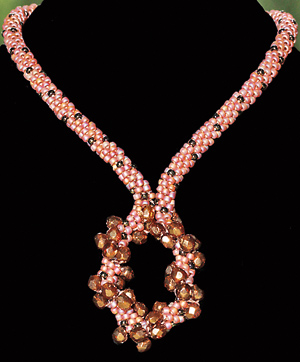Beading together many strands
If a new and exotic genre of jewellery is likely to take your fancy, book a date next Saturday (October 24) to see ‘Pabalu’, an exhibition of finely-crafted beadwork necklaces, earrings and pendants at the Lionel Wendt, from 10 a.m. to 5 p.m.
The exhibition shows the creative talents of Janaki Pethiyagoda, who employs ‘kumihimo’, a technique first invented in Japan that involves braiding strands of cord to create intricate coloured braids. Some 170 items are to be on show, most of them available for sale.
Having acquired her skills under leading experts in Australia and the United States, Janaki has brought her own flavour of stylistic elegance to kumihimo. “Since multiple strands of cords are used,” she says, “the necklaces are strong but slender.
Samurai warriors once used kumihimo as laces for their armour. In fact, even the traditional belt of the kimono was bound by a cord of kumihimo.”
In earlier times, she says, a traditional tool known as a ‘marudai’ was used to form the chains where about eight strands of thread were used to form a braid.
But today this has been revolutionised and beaders have invented a portable disk in its place. Adding beads to braids is a relatively recent innovation, she explains.
“Designing a piece of bead jewellery is quite a challenge. But once you master the art, it is fascinating to create your own designs and colour-schemes.”
In recent times, new types of beads coming into the market have attracted international interest and launched the craft to a wider base of users.
This has made it possible for the beading community and jewellery designers worldwide to innovate fascinating designs which are also original.
Swarovski and Preciosa, traditional Czech bead-makers, are continually inventing new beads and paving the way for new designs. Super Duos, Double twin beads, Triangle beads, and Rivolies, to mention just a few.
Japanese Toho and Miyuki seed-beads in different sizes too, are used for bead weaving, using an altogether different technique. “Whenever I traveI, I head straight for the local bead store and pick up local specialties,” says Janaki.
During a trip to Italy last May, for example, she says she discovered the beautiful beads and focals made in Murano, famous for its glasswork. “Most of these can be seen on necklaces at the exhibition,” she adds.
“The stitches used to make jewellery are ancient but universal,” explains Janaki. “So it becomes a common language worldwide.” Social media, she adds, has helped the craft enormously.
It is a small community of beaders scattered across the globe, but through Facebook, beaders living in different countries can communicate and exchange their designs and ideas with astonishing speed.
Janaki’s passion for beads began when she started a course in jewellery-making in Sydney, Australia. The course included working with silver, copper and steel, among other metals.
“This was exciting but you had to work within the framework of a well-equipped studio, complete with industrial equipment and kilns. It was far too involved and expensive to do as a hobby, in our small apartment.”
But when she started designing with beads, which was another module of the same course, she realized that here was something she could do within the comfort of her home.
It was therapeutic, and for her it has now become a passion. The result of this addiction is a collection of two years’ work, leading to her first exhibition.
Janaki hopes that the exhibition will attract like-minded ladies, and who knows, even a few gentlemen, to form a group to learn the art and socialize.
“It is an enormously creative and enjoyable way to spend your time,”she says. “I hope some interesting people will come to the exhibition, be excited by what they see, and want to learn the art.
For my part, I have no secrets: I am happy to teach what I know!”


